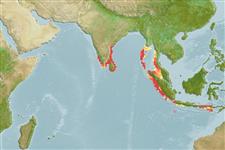Environment: milieu / climate zone / пределы глубины / distribution range
экология
морской ассоциированный с рифами; пределы глубины 1 - 125 m (Ref. 89707), usually 1 - 12 m (Ref. 90102). Tropical; 16°N - 11°S, 75°E - 121°E (Ref. 5222)
Eastern Indian Ocean: southern India, Sri Lanka, and southern Indonesia. However, it is likely that its distribution is continuous from Pakistan to Indonesia. Record from the Chagos Archipelago is based on Epinephelus macrospilos (Ref. 6495).
Size / Вес / Возраст
половая зрелость: Lm ? range ? - ? cm
Max length : 36.5 cm TL самец/пол неопределен; (Ref. 132229); наибольший вес (опубликованные данные): 828.00 g (Ref. 132229)
колючие лучи спинного плавника (общее число) : 11; членистые (мягкие) лучи спинного плавника (общее число) : 16 - 18; колючие лучи анального плавника: 3; членистые (мягкие) лучи анального плавника: 8. Distinguished by having whitish or pale grey color; head, body and fins with numerous close-set round brown spots of unequal sizes; cycloid scales except region under pectoral fins; body with numerous auxiliary scales; greatest depth of body 3.0-3.5 in SL; rounded caudal fin; pelvic fins, 2.2-2.7 in head length (Ref. 90102); further characterized by flat or slightly concave interorbital area, convex dorsal head profile; rounded preopercle, with shallow indentation just above angle and slightly enlarged serrae at the angle; upper edge of operculum slightly convex; subequal posterior and anterior nostrils; maxilla reaches past vertical at rear edge of eye; 2 rows of teeth on midlateral part of lower jaw (Ref. 89707).
Body shape (shape guide): fusiform / normal; Cross section: compressed.
Occurs in shallow waters over coral reefs or rocky substrate. It appears to be a small species; a 17 cm SL fish from Sri Lanka has fairly well-developed ovaries. Solitary (Ref 90102).
Life cycle and mating behavior
половая зрелость | размножение | нерест | икра | Fecundity | личинки
Heemstra, P.C. and J.E. Randall, 1993. FAO Species Catalogue. Vol. 16. Groupers of the world (family Serranidae, subfamily Epinephelinae). An annotated and illustrated catalogue of the grouper, rockcod, hind, coral grouper and lyretail species known to date. Rome: FAO. FAO Fish. Synop. 125(16):382 p. (Ref. 5222)
Статус Красного Списка МСОП (Ref. 130435: Version 2025-1)
Угроза для людей
Harmless
Использование человеком
рыболовство: коммерческий
дополнительная информация
инструменты
Специальные отчеты
Скачать в формате XML
ресурсы в Интернет
Estimates based on models
Preferred temperature (ссылка
123201): 28.1 - 29.4, mean 28.6 °C (based on 216 cells).
Phylogenetic diversity index (ссылка
82804): PD
50 = 0.5000 [Uniqueness, from 0.5 = low to 2.0 = high].
Bayesian length-weight: a=0.01175 (0.00568 - 0.02430), b=3.04 (2.88 - 3.20), in cm total length, based on LWR estimates for this Genus-body shape (Ref.
93245).
Trophic level (ссылка
69278): 3.7 ±0.6 se; based on size and trophs of closest relatives
устойчивость к внешним воздействиям (ссылка
120179): средний (среднего размера), минимальное время удвоения популяции 1.4-4.4 года (Preliminary K or Fecundity.).
Fishing Vulnerability (Ref.
59153): Low to moderate vulnerability (27 of 100).
🛈
